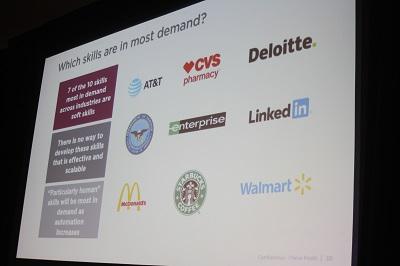By Joshua Seidemann, Vice President of Policy, NTCA–The Rural Broadband Association
January 11, 2019
I participated in an audiology screening; I swabbed my inner cheek 10x for DNA; I played cornhole.
I was a human at CES.
But, even in those “back to basics” experiences (well, as if a do-it-at-home DNA screening could be basic), eyes are toward the future.
In sessions devoted to emerging job trends, panelists challenged educators and government to take a systemic look at education to determine how a system ostensibly designed to meet the needs of the industrial revolution can be reformed to meet the needs of the virtual revolution.
Consider that many so-called “first jobs” are disappearing at a rate 20x that of high-wage jobs, many due to automation. To be sure, we have discussed in this blog from time to time the notion that robots and automation should create jobs, rather than create an overall mathematical loss in the job market. But that assumption is predicated on workers learning new skills and up-and-coming workers being graduated with the right skills. An audience member asked what hope there might be for a coal miner, and the answer was positive: transferable skills. Machine operation; management; maintenance and repair and problem solving. The last is probably the most important.
That’s today’s human commentary on technology: education. Behind the $398 billion in U.S. tech revenues are human beings who imagine, design, develop and deploy the technology.
Seven of the top ten skills that are demanded by large employers are “soft skills” – talents that machines cannot provide. These include teamwork, communications and problem solving. Several initiatives in Appalachia recognize this, training former or current coal mine workers in software development, leading to apprenticeships and public sector jobs designing websites and developing apps.
And then add in that high-skill jobs are all STEAM (science, technology, engineering, arts and math) and the need to nurture talent from a young age becomes clear.
That’s today’s human commentary on technology: education. Behind the $398 billion in U.S. tech revenues are human beings who imagine, design, develop and deploy the technology. Are there obstacles and hazards to be avoided along the way? Of course – pervasive technology that gathers, uses and stores data creates tremendous privacy concerns. One speaker this morning warned against “techlash,” while another warned that the honeymoon among tech and lawmakers is over – we are now entering the more critical stage of a “relationship.”
Indications of that relationship are seen in the numerous privacy initiatives being staked out by various arms of the federal government. Last month, the National Telecommunications & Information Administration (NTIA) gathered comments on consumer privacy (NTCA’s comments here); the National Institute of Standards and Technology has asked for similar contributions by next Monday; and the Federal Trade Commission has requested comments in March 2019 following a series of public hearings.
But these concerns are challenges to be met by humans, using teamwork, empathy and problem solving, as only humans can do – provided the educational foundation they need to enter these fields is ensured.


